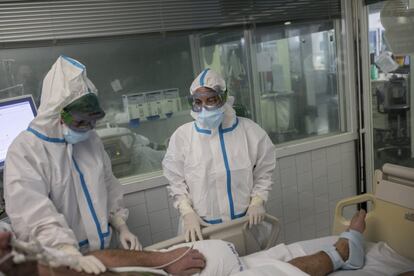Coronavirus incidence rate in Spain falls 64% in a month, with almost all regions now under 300 cases per 100,000 inhabitants
Just over 370 new Covid-related fatalities were added to the official death toll on Wednesday, according to the latest Health Ministry report

The number of new coronavirus cases in Spain continues to fall. The start of this ongoing descent was first recorded a month ago, on November 9. According to the Spanish Health Ministry’s latest report, released on Wednesday evening, the 14-day cumulative number of cases per 100,000 inhabitants is now below 300 in nearly every Spanish region and territory. Only the Basque Country (309) and Asturias (304) are above this level. The average incidence rate across Spain now stands at 193.26, down from a peak of 529.43 a month ago – a fall of 63.5%.
The Health Ministry report published on Wednesday also includes figures from Tuesday, when no data was released as it was a public holiday in many regions. According to the report, 9,836 new coronavirus cases were recorded in the two days, bringing the total number of infections since the beginning of the pandemic to 1,712,101. These figures, however, should be viewed with caution, given that there is often underreporting over weekends and public holidays. In some regions, Monday, December 6 was also a public holiday, resulting in a four-day long weekend.
Once you apply rigorous restriction measures, the impact is huge and the risk of contagion is going to be reducedJosé Martínez Olmos, former secretary general for health
The number of Covid-19 fatalities should also be treated with the same caution. The Health Ministry added 373 victims to the official death toll, which now stands at 47,019. This equates to an average of 167 deaths over the two-day period, a number not seen since October 28.
Pressure on Spain’s hospitals is also easing, according to Wednesday’s report. Covid-19 patients now occupy 9.91% of all hospital beds, down from 27.28% a month ago. The occupancy rate in intensive care units (ICUs) has also fallen. When the Health Ministry issued its previous report on December 4, Covid-19 patients occupied 24.64% of ICU beds. On Wednesday that figure had fallen to 22.93%.
“The pandemic is evolving fairly well, but we are still far from where we have to get to,” said Health Minister Salvador Illa on Wednesday, in reference to the government’s goal to reduce the 14-day cumulative number of cases per 100,000 inhabitants to 25.
But while the incidence rate has fallen sharply in the worst-affected regions, with Murcia, Navarre and Aragón recording drops of more than 70% in a month, the fall has not been as significant in the regions with the best epidemiological data. In Galicia, Madrid, Asturias and the Balearic Islands, the incidence rate has dropped by less than 50% in a month. And in the Canary Islands it has even risen 12%, although the region still has the lowest figure in the country.
Patricia Guillem, an epidemiologist from the European University in Valencia, said this situation is normal. “The fall is greater in regions that have greater incidence, because the higher it is, the more significant the change. What’s more [this fall] is essential because the figures they had were very worrying,” she explained.

Incidence rate falling, but at a slower rate
Another issue is that the incidence rate is falling at a slower rate. In the last few days, it has only dropped by 58 points, compared to the 112-point drop between November 20 and 27. This has raised concern that it will be increasingly difficult for Spain to reach its goal of lowering the 14-day cumulative number of cases per 100,000 inhabitants to 25. Former Interior Minister Miguel Sebastián said that the incidence rate will not fall to an acceptable level until January 13. And that is not taking into account the risk of new outbreaks following the Christmas holiday period.
Ramón Gálvez, the former public health chief of Castilla-La Mancha, argued tougher coronavirus restrictions were needed to bring down the incidence rate. “The problem is the force with which you act,” he explained. “If they are weak containment measures, you are not going to eradicate the virus in the region. The example of a strategy to eradicate the virus with drastic measures is China, which currently has 4,746 deaths, when Spain already has more than 46,000.”
He added: “In Spain and Europe, they have preferred containment to lower the figures, compared to contention to eradicate the virus, and they have accepted 250 to 350 people dying every day in the second wave as though it were normal.”
José Martínez Olmos, who was the secretary general for health between 2005 and 2011, agreed on the need for stricter restrictions. He explained that “a large part of the high incidence rate is linked with mobility. Once you apply rigorous restriction measures, the impact is huge and the risk of contagion is going to be reduced.”
Pedro Gullón, from the Spanish Epidemiology Society (SEE), also supported this view. “I am worried that the measures will be relaxed more, that people will relax – people will do what they are allowed to do. Perhaps some places are reopening with transmission levels that are still too high, even though the trend is good.”
False sense of security
Another concern is that the increased use of antigen tests, which provide faster results than the traditional PCR diagnostics, may be creating a false sense of security. Victoria Zunzunegui, a former professor of epidemiology at Montreal University, explained: “Antigen tests are excellent, with sensitivity and specificity similar to PCR in terms of confirming a diagnosis, but they have a very low sensitivity in the general population and this sensitivity falls to below 50% when used in a mass testing scenario.”
According to the latest data, Madrid has carried out 92,000 antigen tests compared to 58,000 PCRs, while in Castilla y León, these figures are 39,000 and 25,000, respectively. Olmos warned: “The greater use of fast testing for diagnoses implies that there is greater risk of underestimating the incidence rate due to false negatives.”
English version by Melissa Kitson.
Tu suscripción se está usando en otro dispositivo
¿Quieres añadir otro usuario a tu suscripción?
Si continúas leyendo en este dispositivo, no se podrá leer en el otro.
FlechaTu suscripción se está usando en otro dispositivo y solo puedes acceder a EL PAÍS desde un dispositivo a la vez.
Si quieres compartir tu cuenta, cambia tu suscripción a la modalidad Premium, así podrás añadir otro usuario. Cada uno accederá con su propia cuenta de email, lo que os permitirá personalizar vuestra experiencia en EL PAÍS.
¿Tienes una suscripción de empresa? Accede aquí para contratar más cuentas.
En el caso de no saber quién está usando tu cuenta, te recomendamos cambiar tu contraseña aquí.
Si decides continuar compartiendo tu cuenta, este mensaje se mostrará en tu dispositivo y en el de la otra persona que está usando tu cuenta de forma indefinida, afectando a tu experiencia de lectura. Puedes consultar aquí los términos y condiciones de la suscripción digital.
More information
Últimas noticias
Most viewed
- Sinaloa Cartel war is taking its toll on Los Chapitos
- Oona Chaplin: ‘I told James Cameron that I was living in a treehouse and starting a permaculture project with a friend’
- Reinhard Genzel, Nobel laureate in physics: ‘One-minute videos will never give you the truth’
- Why the price of coffee has skyrocketed: from Brazilian plantations to specialty coffee houses
- Silver prices are going crazy: This is what’s fueling the rally










































